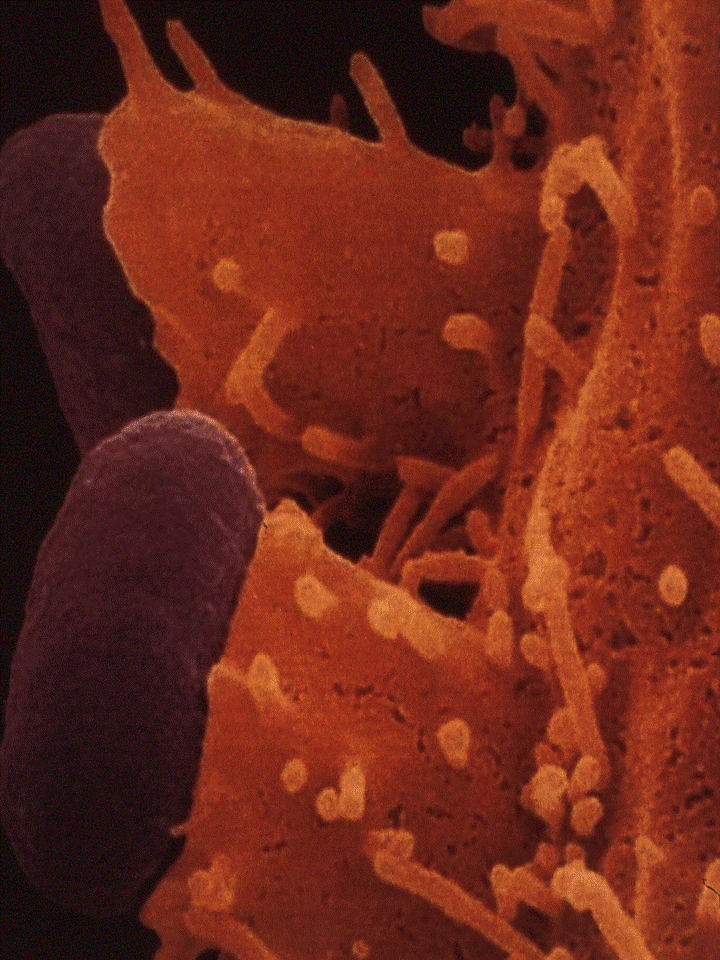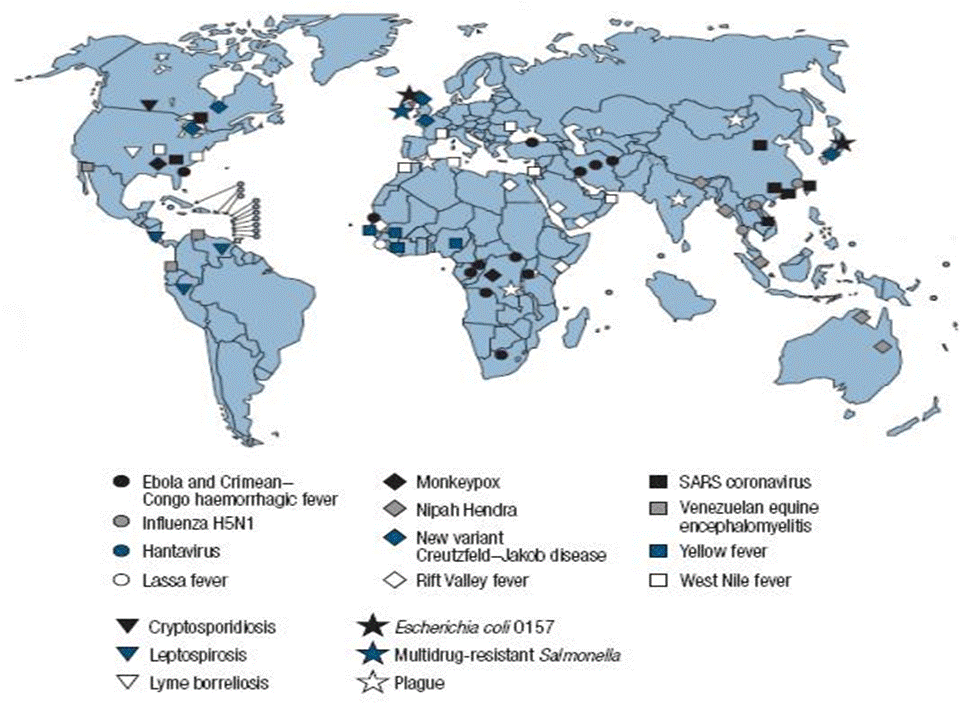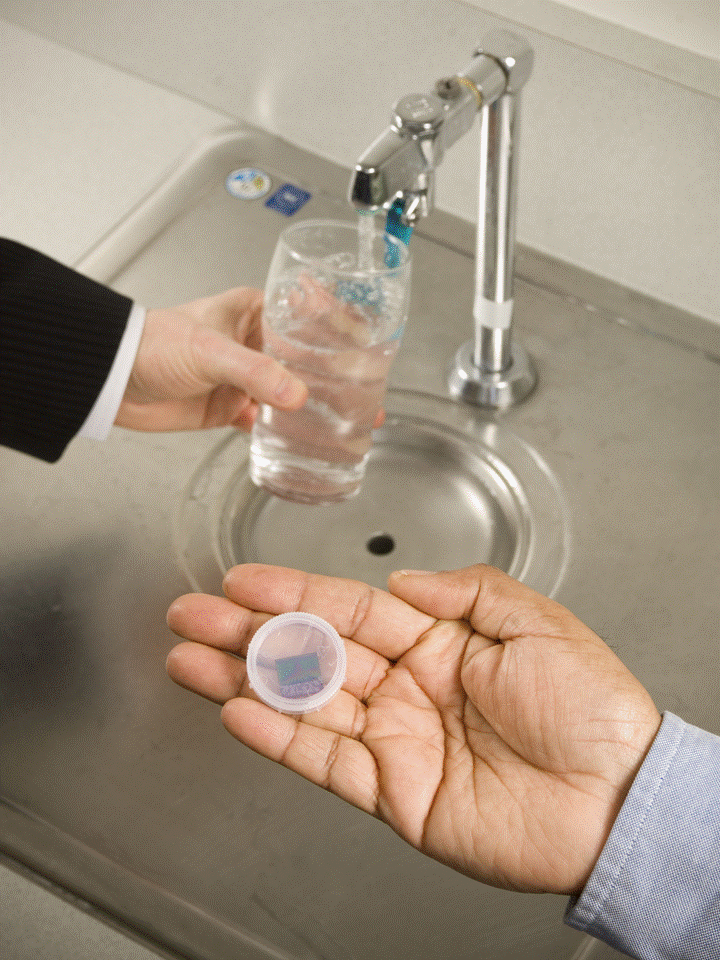Biohazards are the greatest threat to humankind
Biohazard outbreaks from pathogens and infectious diseases occur every day in the U.S. and throughout the world from Avian Influenza virus, HIV/AIDS, Hepatitis viruses, Norovirus (Norwalk virus), Salmonella bacteria, Mycobacterim tuberculosis bacteria, Vibrio cholerae bacteria (cholera), MRSA superbugs, Plasmodium parasites (malaria) and hundreds of other microorganisms. Bacteria, viruses and parasites are responsible for the bulk of the 18.4 million deaths worldwide from communicable diseases in 2004 estimated by the World Health Organization plus additional deaths from non-communicable diseases and cancers. Pathogens currently infects billions of people and trends indicate a rising number of pathogen deaths and infections from population growth in developing countries, urbanization, poor sanitation, broken water infrastructure, reduced food safety, globalization, international travel, extreme weather, and the rising costs of new drugs, vaccines and antibiotics. Many of these deaths are premature and preventable. The key to preventing major outbreaks is frequent and comprehensive testing for each suspected pathogen, as most occurrences of pathogens are not detected until after people get sick or die. With advances in nanotechnology, biotechnology, information technology and wireless technology, new generations of low cost biosensors and early warning systems will provide a front line of defense against the transmission of deadly pathogens.
Recognizing the biggest threat to humankind
It is easy to recognize the biggest threat to humankind. Just count the dead, the dying, environmental damage, and economic costs. 
The world record holder for human deaths is Yersinia pestis. This disease-causing bacterium killed as many as 75 to 100 million people during the Black Plague, or roughly 20% of the world’s 450 million population in the 14th century [1].
Also at the top of the list is the Influenza virus. One strain, the Influenza A H1N1 virus or Spanish Flu killed as many as 50 million people in 1918 [1]. Unlike the Black Plague which took many years for its deadly transmission to take place, most of the Spanish flu deaths took place in only one year. In 2009, a new strain of the Influenza A H1N1 virus or Swine Flu resulted in dozens of deaths and fears of a possible worldwide pandemic.
Another Influenza virus strain is the Avian Influenza H5N1 virus or Bird Flu that at present mainly affects the bird population. Recent outbreaks caused the urgent culling of 3.5 million poultry in Saudi Arabia in November 2007 [2] and 2.9 million poultry in India in January 2008 [3] due to the fear of the strain mutating into a form more easily transmitted to people. The Bird Flu killed 103 out of 126 infected people in Indonesia by the end of February 2008 [4], an 82% mortality rate so far. In anticipation of a possible Influenza virus pandemic, the UK government announced an emergency plan to permit as many as 700,000 dead bodies to be rapidly processed using mass graves, inflatable mortuaries, 24-hour cremations and express funerals [5]. In 2008 the World Bank predicted that a Flu pandemic could kill 71 million people worldwide and cause a major global recession costing more than $3 trillion [5a].
Another virus, the Human Immunodeficiency Virus or HIV currently infects 33.2 million people around the world [6]. HIV causes Acquired Immune Deficiency Syndrome or AIDS by damaging immune systems which protects people against diseases by killing pathogens and tumor cells. AIDS killed 2.1 million people in 2007 which is triple the 700,000 AIDS deaths in 1993 only 14 years earlier. The annual AIDS death rate is believed to have peaked. Over two thirds of AIDS sufferers live in Africa where eight countries have over 15% of its adult population infected with AIDS. According to the WorldWatch Institute, the gross domestic product of 33 African countries with a significant HIV/AIDS population declined by an average of 1.1 percent per year between 1992 and 2002. The combined loss in GDP from these countries is projected to reach $144 billion by 2020 [7].
Emerging and Re-emerging Infectious Diseases: 1996-2004

Source: World Health OrganizationMore people are infected with the Hepatitis C virus than with HIV. China alone has 38 million Hepatitis C sufferers affecting over 3% of its entire population [8]. China’s high Hepatitis C infection rates are believed to be linked to illegal blood and plasma donation practices during the 1980s and early 1990s, and failure to screen transfusion recipients [9]. About 85% of those infected with Hepatitis C Virus become chronically infected with the virus which replicates and can slowly attack the liver over a period of decades. This results in advanced liver scarring or cirrhosis in 10 to 20% percent of cases. Liver cancer develops in 1 to 5% of cases [10].
China was also the home to the Severe Acute Respiratory Syndrome or SARS epidemic in 2002 caused by the SARS coronavirus. China’s inaction in containing the virus and delay in informing its citizens and the World Health Organization of the outbreak have been cited as significant factors that caused the wide transmission of SARS [11]. China’s national tourist bureau estimated China’s loss from the SARS outbreak to be $8.8 billion in tourism revenue from foreign sources and an additional $24.5 billion from domestic sources [12]. The World Health Organization claims that loss of tourism revenue is a primary factor for countries to not report epidemics.
Another respiratory infection is tuberculosis (TB) caused by the Mycobacterium tuberculosis bacteria. The World Health Organization estimated that in 2006 1.5 million people died from TB plus another 200,000 died from HIV associated with TB [13]. A TB infected person typically infects 10 to 15 new people each year through coughing, sneezing, talking or spitting. One-third of the world's population is believed to be infected with the TB bacillus with nine million new cases occurring each year. While TB can become non-infectious and cured if properly treated, about one quarter of the new cases are multi-drug resistant. These drug resistant strains are highly concentrated in south-western Russia and nearby countries in the former Soviet Union [14].
The emergence of antibiotic resistant Superbugs
Closer to home, the Methicillin-resistant Staphylococcus aureus or MRSA bacteria kills nearly 19,000 Americans every year [15] which is more than the annual number of AIDS deaths in the US.
MRSA affects about 2 million Americans and costs $20 billion a year due to its high incidence in health-care facilities. Health care facilities have a high immuno-compromised population with weakened immune systems, cancer and surgical patients, organ transplant recipients, HIV patients, elderly, malnourished, pregnant, new born and sick kids, who are least able to fight off invading pathogens. When MRSA adds a severe illness to a patient’s original medical condition, the death rate increases by 4 times, and hospital stays are extended, making other patients wait longer for their treatments. MRSA infections are increasingly appearing in places where people are in close contact such as locker rooms, military facilities, and prisons.
The Infectious Diseases Society of America (IDSA) has listed MRSA as one of 6 extremely dangerous superbugs which are not readily killed by antibiotics [16]. IDSA’s five other superbugs are Acinetobacter baumannii which is a growing cause of hospital-acquired pneumonia with mortality rates range of 20 to 50%; Aspergillus fungus with a 50-60% death rate; Vancomycin-resistant Enterococcus faecium (VRE) a major cause of bloodstream infections, infections of the heart, meningitis, and intra-abdominal infections; Pseudomonas aeruginosa (P. aeruginosa) a hospital-acquired pneumonia following surgery and urinary tract infections with a particular threat to children with cystic fibrosis; and Escherichia coli (E. coli) and Klebsiella spp. which are the major causes of urinary tract, gastrointestinal tract, and wound infections. In addition to these superbugs which are mostly bacteria, antibiotics have no effect on viruses or viral infections.
Pathogens are the primary cause of food poisoning
The Centers for Disease Control and Prevention (CDC) estimates that food poisoning affects 76 million Americans each year or 25% of the entire US population [17]. If the US rate is applied globally where most of the world’s population has less stringent food safety regulations and  hygienic standards than in America, then as many as 1.5 billion people acquire food poisoning each year.
hygienic standards than in America, then as many as 1.5 billion people acquire food poisoning each year.
Some of the most common foodborne biohazards are Salmonella bacteria which are commonly found in poultry, eggs, unprocessed milk and meat; Campylobacter bacteria which infect people from undercooked chicken; Listeria bacteria which are found in soft French style cheeses, pates, uncooked hot dogs and sliced deli meats; and Toxoplasma gondii, a parasitic protozoa transmitted from under cooked meats and contact with cats, and is particularly dangerous to pregnant woman and their unborn children. Norovirus (Norwalk virus) is primarily spread from infected people such as kitchen workers contaminating restaurant food. The CDC lists 34 cruise ships in 2006 having Norovirus or other pathogens outbreaks affecting 5% or more of their passengers [18].
Food can be infected by biohazards at anytime in the processing cycle. Fresh fruits, vegetables and seafood can be contaminated by pathogens if they are washed or irrigated with water contaminated with animal manure or human sewage. In 2008 a Salmonella Saintpaul outbreak in possibly from imported Jalapeno peppers from Mexico linked to 1,442 cases, 286 hospitalizations, and 2 deaths in the US [18a]. CNN also reported on the Lou Dobbs shows that the outbreak caused 30,000- 40,000 unreported illnesses and between $100 - $250 million in economic losses. In 2009 a Salmonella Typhimurium outbreak caused by peanut butter resulted in 9 deaths and 691 illnesses in the US [18b]. Meat and poultry can be infected with biohazards when the animals are being raised, slaughtered, processed into food products, mixed with infected ingredients, or improperly handled in stores, transport, or in meal preparation. In 2008, 20 people died from a Listeria outbreak in Canada which was traced to a Maple Leaf Foods meat-packing plant [18c]. In the kitchen, microbes can be transferred from one food to another food by using the same contaminated knife or cutting board. Lightly infected food left unrefrigerated overnight can become highly infectious in the morning.
Biohazards found in food have led to major recalls with enormous economic consequences. In the early 1990’s a pathogenic prion protein from infected sheep was fed to cattle and caused a BSE (bovine spongiform encephalopathy) or Mad Cow Disease epidemic in the UK affecting as many as 200,000 cattle [19]. Evidence suggested that when people eat diseased tissue from BSE cattle they can become infected with variant Creutzfeldt-Jakob disease (vCJD), the human form of mad cow disease. In 2003, the first Mad Cow Disease case was detected in the US from a cow imported from Canada. The U.S. beef industry claimed losses in 2004 of up to $4.7 billion [20] while a 26 month ban on Canadian beef entering the US cost Canadian producers around $5.7 billion [21]. Even with the potential risks, the current low incident of Mad Cow Disease in the US has allowed testing to be scaled back to only 0.1% of the 37 million cows slaughtered each year [22].
Related events include the culling of 6 million sheep, cattle and pigs along with £5.6 billion in economic losses and government payouts from Picornavirus which caused a Foot and Mouth Disease Outbreak in the UK in 2001 [23]; a recall of 21.7 million pounds of frozen ground beef patties infected with E. coli O157:H7 from Topps Meat Company of New Jersey in September 2007 [24]; and a recall of 143 million pounds of beef from cows that could not walk and believed to pose a higher contamination risk from E. coli, mad cow disease and salmonella from Westland/Hallmark Meat Co in California in February 2008 [25].
Animals on farms, in the wild and domestic pets are also potential sources of pathogens. One source of infection is the fecal oral route of infected animal feces finding their way into people’s mouths by touching an infected surface containing animals’ feces. Pet owners kissing their pets or touching their mouths after playing with their pets can also be at risk. Other infectious routes include scratches, bites, breathing droplets containing feces, or bites from insects or fleas present on the animals.
Pathogens in water is a massive global problem
According to the World Health Organization, 1.1 billion people lack access to safe water and 2.6 billion people lack access to proper sanitation [26]. The greatest source of these problems is  waterborne bacteria, viruses and parasites coming from raw sewage, infected feces and industrial biowaste that are not adequately sanitized before entering the water supply.
waterborne bacteria, viruses and parasites coming from raw sewage, infected feces and industrial biowaste that are not adequately sanitized before entering the water supply.
Diarrheal diseases from drinking contaminated water kill 1.8 million people each year, mostly children under 5 in developing countries [26]. The biggest source of diarrheal diseases is Vibrio cholerae bacteria which causes Cholera, a rapidly fatal illness that could kill people in as little as three hours if treatment is not provided. In 2009 a cholera outbreak in Zimbabwe water killed 4,037 and infected over 91,000. Another bacterium, Salmonella typhi causes typhoid fever which affects 21 million people every year and kills 200,000 [27].
When infected water is used to irrigate crops, feed animals, or is dumped near fish and shellfish, pathogens can contaminate the food chain. Intestinal helminth infections from parasites such as Ascaris lumbricoides often leads to severe consequences such as cognitive impairment, massive dysentery, or anaemia and affects 133 million people with 9,400 deaths every year [26].
Other pathogens enter the body on contact. The Schistosoma parasite is contracted when swimming and infects 160 million people with schistosomiasis, causing tens of thousands of deaths every year mainly in sub-Saharan Africa [26]. When the Chlamydia trachomatis bacteria comes in contact through peoples’ eyes through washing or damp linen, it causes trachoma which threatens blindness in 146 million people including 6 million who are already visually impaired[26].
Pathogen-induced diseases can also be closely associated with the availability of water, particularly when the pathogens are transmitted by insects whose larva develops in water bodies. Plasmodium parasites cause malaria which infects 300 to 500 million people and kills over one million each year [26]. Irrigation systems and reservoirs in hot climate countries increase mosquito breeding sites and accelerate the transmission of malaria. Other pathogens transmitted by mosquito include Flavivirus (Dengue Fever) and West Nile virus (neuroinvasive illness and West Nile fever). West Nile virus from disease carrying mosquitoes have been found in abandoned pools at foreclosed homes in California resulting from the US sub-prime mortgage crisis [28].
Chlorination can give a false sense of security
People living in industrialized countries have a much lower risk of contracting a water-borne pathogen. One principal reason is that drinking water is usually treated with chlorine or other disinfectants that kill bacteria such as Vibrio cholerae (cholera), and Salmonella typhi (typhoid fever).
However, chlorination can give a false sense of security as protozoan parasites such as Cryptosporidia and Giardia lamblia, and viruses like hepatitis A and E, rotavirus, Norovirus, poliovirus and echovirus can be present in drinking water even when water is chlorinated. People can become extremely sick by swallowing a few protozoa since they rapidly reproduce once inside a host organism. Cryptosporidium caused a cryptosporidiosis outbreak in Milwaukee in 1993 that resulted in over 400,000 cases of serious illness and 100 deaths, principally among AIDS patients [29].
Chlorination systems can become ineffective when overwhelmed by severe weather, heavy rains and floods. In November 2007, doctors in Pascagoula, Mississippi began petitioning local authorities to relocate a wastewater treatment plant after Hurricane Katrina's storm surge diverted raw sewage from the plant into nearby homes, businesses and industrial facilities, and causing potential contamination from salmonella, shigella, campylobacter, vibrio, hepatitis and flesh-eating diseases [30].
 In 2000, heavy rains brought livestock manure laden with E.coli 0157:H7 and Campylobacter jejuni bacteria into Walkerton, Ontario’s water supply. Half of the town’s 5,000 residents were sickened and 7 died [31]. Following the incident, it was found that 25 miles of the town’s pipeline was filled with biofilm that became a breeding ground for E.coli and other pathogens to obtain nutrients and multiply. E.coli contained in biofilms are extremely resistant to chlorine, and can be released into the drinking water when there is a significant pressure change in the water distribution system due to an industrial plant turning on a production process or a fire hydrant being opened.
In 2000, heavy rains brought livestock manure laden with E.coli 0157:H7 and Campylobacter jejuni bacteria into Walkerton, Ontario’s water supply. Half of the town’s 5,000 residents were sickened and 7 died [31]. Following the incident, it was found that 25 miles of the town’s pipeline was filled with biofilm that became a breeding ground for E.coli and other pathogens to obtain nutrients and multiply. E.coli contained in biofilms are extremely resistant to chlorine, and can be released into the drinking water when there is a significant pressure change in the water distribution system due to an industrial plant turning on a production process or a fire hydrant being opened.
Pathogens can also enter the water supply after the water is treated. Cities with aging or broken watermains, new developments that have left dead ends in the old water network, and pipelines connected to wells can allow pathogens to access the water supply. Pathogen sources can include storm run offs, industrial and agricultural by-products, leaking septic tanks, untreated waste from infected animals and people, and cemeteries. The EPA estimates that the expense to repair and replace the US water and wastewater infrastructure could cost up to $1 trillion over the first 20 years of the twenty-first century [32]. Many communities and individuals get their drinking water from underground wells or surface water which have no treatment at all. As well, some people especially children drink water from potential sources of pathogens such as hotwater tanks, swimming pools, waterparks, and ice bins in hotels.
The biohazard problem has not yet reached its peaked
The following trends indicate that the biohazard problem has not yet reached its peaked.
- The world’s population is the highest in history and still increasing. United Nations’ statistics reveal that the world’s population had increased by 5 billion people during the twentieth century from 1 billion to 6 billion people [33]. As the population increases so does the number of sick and vulnerable people who are least able to fight off pathogens.
- Developing countries currently make up 80% of world’s population [33]. With the world’s fastest growing population in Africa and slow or negative growth in industrialized nations, more people will be living with improper sanitation, unsanitized water, inadequate food, and a lack of basic medicines. This will further increase biohazard morbidity and mortality.
- Population in urban areas is rising at the rate of 1 million people per week [33]. When people live in close proximity, pathogens can more quickly spread as was experienced during plagues and epidemics. Increased city populations put added stress on water mains with a greater water demand for drinking and industrial water, and a greater output of sewage water from human and industrial waste. An increased demand on urban hospitals puts more people at risk of infections and disease. A greater use of antibiotics and drugs to control pathogens is also creating new families of multiple drug-resistant microbes.
- Urbanization also requires land and forests to be cleared to make way for more housing. Microorganisms living in the forests are forced to enter populated areas. A greater demand for food and biofuels that are produced from crops also increases the demand for water, as well as greater output of fertilizer and animal feces into the water supply.
- Mass production of food leads to lower food safety and high risk practices. These include grinding up dead animal parts to feed live animals and introduce unnatural organisms to the food supply as in the case of Mad Cow disease. When food is imported from vicinities with lower safety standards little can be done to prevent animals from being infected with biohazards when sewage water is used to increase their weight. Organic foods which are not produced with herbicides or pesticides that can kill dangerous microorganisms also increase the risk of pathogens to people.
- Extreme weather appears increasingly more frequently. This can overwhelm a water network and bring pathogens past safeguards. Hot climate diseases such as cholera, malaria and yellow fever are increasingly appearing in milder regions where there is a higher population.
- More people in the world increase the potential for sexually transmitted diseases (STD) and unprotected sex with multiple partners. While HIV/AIDS is the most deadly sexually transmitted disease and most common in Africa, it is not the only STD. In March 2008, the Centers for Disease Control and Prevention found that 26% of American girls between 14 and 19 have at least one sexually transmitted disease [34].
- Globalization including international trade and travel is accelerating the transmission of pathogens. This is especially the case for trade between industrialized nations such as North America and Europe and developing nations such as China and India pathogens where contact is made between previously unexposed people and food products. The World Health Organization estimated 2.1 billion airline passengers travel each year [35]. Airline passengers are as risk of pathogen exposure. For example, airplanes typically fill galley water from local countries sources which can bring pathogens into airplane water and ice. In May 2007 an Air France passenger exposed other passengers with extensively multidrug-resistant tuberculosis. There are virtually no procedures preventing pathogens to be transmitted from travelers, illegal immigrants or people displaced from war or natural disasters. Increased trade also means more transportation of biohazards to testing labs and research centers with a greater chance of the pathogen being improperly handled and people being exposed.
So where do we go from here?
Billions of people throughout the world are at increasing risk of contracting hundreds of different pathogens from the water, food, air, surfaces, people, animals and insects. Not only do pathogens accumulate in human bodies, unlike chemical toxins pathogens are living organisms and once inside a person pathogens reproduce and increase their potency as they grow in numbers to infect and potentially kill its hosts.
Over the years advances in medical research and technologies have produced disinfectants, antibiotics and vaccines which have greatly reduced the spread of pathogens mostly in industrialized countries. However, with countless investments only one infectious disease, smallpox from the Variola virus, has been completely eradicated. According to the WorldWatch Institute old illnesses such as tuberculosis, malaria, and cholera have spread geographically and more than thirty previously unrecognized diseases such as Ebola, HIV, Hantavirus, and SARS have emerged as new threats to human well-being [7].
Microorganisms have survived on the earth for 4 billion years by adapting to the most severe environments. This is seen today as drug resistant pathogens which have no treatment or cure. Even if new drugs or vaccines are developed for a particular pathogen, exorbitant prices can limit their use to only a small percentage of the sufferers who need it. As well, a particular drug or vaccine might only be useful for a single pathogen and ineffective on the next outbreak.
In every case of human and economic catastrophe from biohazards and infectious disease, pathogens had entered into a geographic area and were rapidly transmitted to a greater area. Early detection and containment is the simplest and most effective way to prevent human, animal, and environmental catastrophes.
With advances in nanotechnology, biotechnology, information technology and wireless technology, new generations of low cost biosensors and early warning systems will provide a front line of defense against the transmission of pathogens. Individual bacteria, viruses and protozoa parasites will be rapidly detected at transmission sources, then contained and prevented from spreading. This will stop the mass transmission of illness and death along with the massive economic consequence associated with major outbreaks.
Nanotechnology-based biosensor
for the detection of biohazards
(Source: NASA)
References
[1] 7 Worst Killer Plagues in history, Oddee Blog, October 15, 2007 and Black Plague, Wikipedia
[2] Saudi hit by bird flu - 3.5mn birds killed, Arabian Business.com, November 22, 2007
[3] Indian state says bird flu under control Bangladesh reports spread, Agence France-Presse, February 2, 2008
[4] Woman's Death Brings Indonesian Bird Flu Toll to 103, Associated Press, February 2, 2008
[6] Joint United Nations Programme on HIV/AIDS, Website
[7] State of the World 2005 Trends and Facts - Containing Infectious Disease, World Watch Institute
[8] Report: about 38 mln Chinese carry hepatitis C virus, China View, November 22, 2007
[9] Past illegal blood donation in China linked to hepatitis C virus infection, Medical News Today, October 22, 2005
[10] Hepatitis C, An Update, U.S. Food and Drug Administration, FDA Consumer magazine, July-August 2001
[11] SARS: 1.3 billion Chinese left in the dark, Asia Times, April 3, 2003
[12] China, SARS and the Economy, Encyclopedia Britannica Online, Year in Review 2003
[13] A World Free of TB and WHO factsheet no. 104 – Tuberculosis, World Health Organization
[14] Anti-Tuberculosis Drug Resistance in the World, World Health Organization
[15] Staph Killing More Americans Than AIDS, National Public Radio, October 18, 2007
[16] IDSA Releases Hit List of Dangerous Bugs, Infectious Diseases Society of America, March 1, 2006
[17] Food-Related Illness and Death in the United States, Centers for Disease Control and Prevention, Vol. 5, No. 5, September–October, 2000
[18] Outbreak Summaries for International Cruise Ships, Centers for Disease Control and Prevention
[19] Transmissible spongiform encephalopathies (TSEs) Statistics for Cattle surveillance, UK Department for Environment, Food & Rural Affairs (DEFRA)
[20] The Cows Have Come Home, CorpWatch, September 1, 2005
[21] Canada cows cross U.S. border, High Plains/Midwest AG Journal, July 21, 2005
[22] Too little testing for mad cow, critics say, The Press-Enterprise, March 13, 2008
[23] Foot and Mouth Disease, UK Department for Environment, Food & Rural Affairs (DEFRA)
[24] 21.7 million pounds of beef recalled, CNN, September 30, 2007
[25] Largest Beef Recall In US History, 143 Million Pounds Worth, Medical News Today, February 18, 2008
[27] Typhoid Fever, Centers for Disease Control and Prevention, October 24, 2005
[28] Festering Pools Left Behind at Foreclosed Homes Pose Health Risk, KPBS, November 22, 2007
[29] Emerging Issues in Water and Infectious Disease, World Health Organization, 2003
[30] Doctors want wastewater plant moved, The Mississippi Press, November 22, 2007
[31] Walkerton businesses get short shrift, The Star, February 8, 2008
[32] Clean & Safe Water for the 21st Century, The Water Infrastructure Network, 2000
[33] The World at Six Billion, United Nations Department of Economic and Social Affairs, 1999
[34] STD's Affect 26 Percent of Female Teens, Health News, March 24, 2008
[35] The World Health Report 2007 - A safer future: global public health security in the 21st century, World Health Organization, 2007